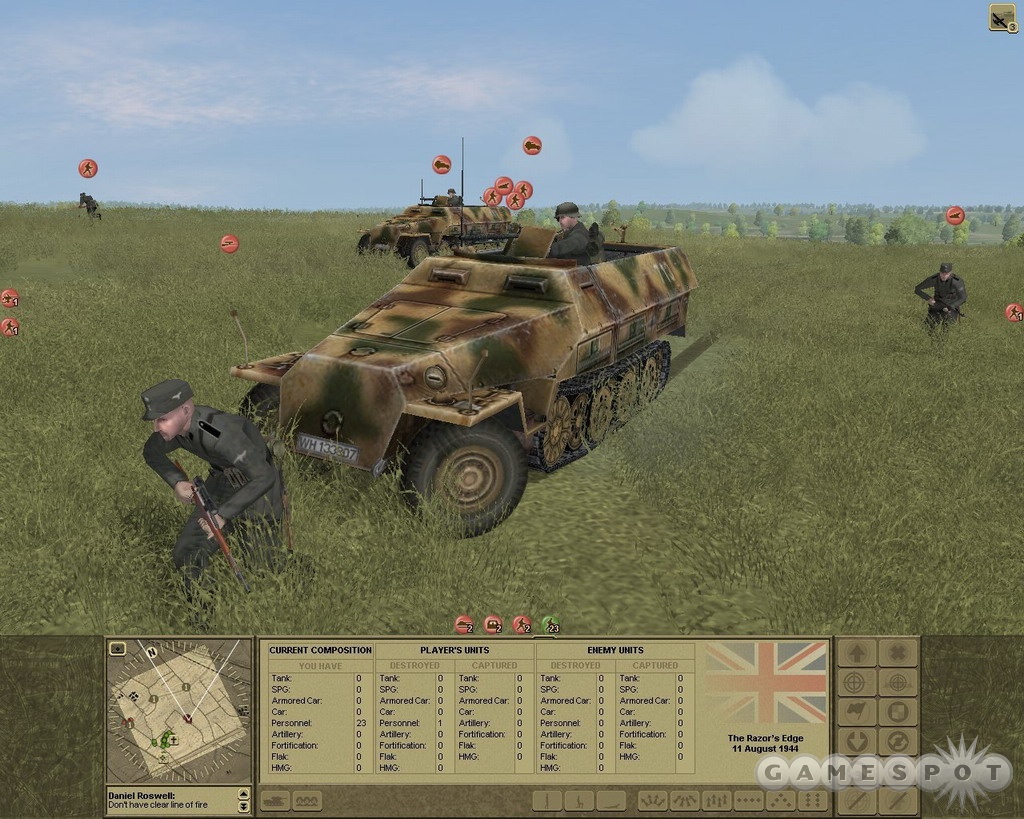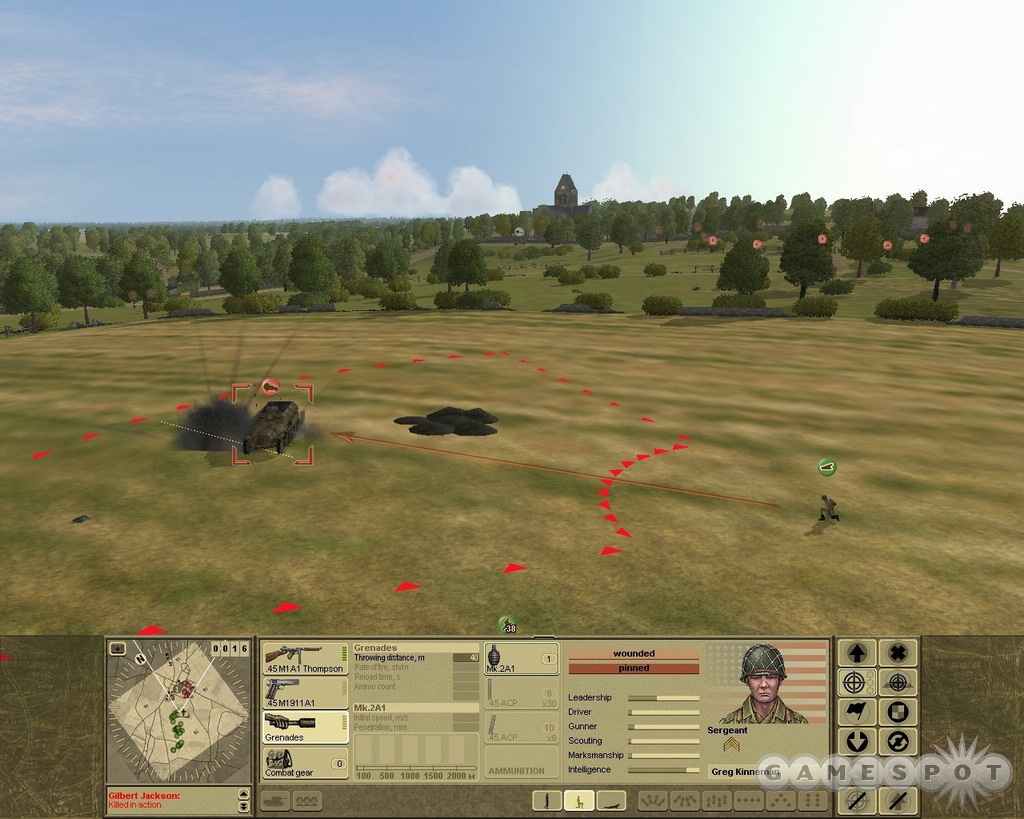Word War II real-time strategy game exhaustion is so well established in gaming these days that the genre seems incapable of surprising anybody. Even the standouts, such as Company of Heroes, follow a template so well worn that it has grooves; thus, Theatre of War comes as a shock. 1C Company's take on the old Axis-versus-Allies thing replaces RTS conventions with realistic battlefields, line of sight, and weapon range. Its tactical focus and total absence of resource gathering or base building make the learning curve a little twisty for tank-rush types. However, the authenticity and atmosphere bring the Second World War to life in impressive fashion.

Scope and scale are the biggest differences between Theatre of War and the usual WWII RTS. Five campaigns, plus a handful of standalone battles, let you guide troops from the US and UK, USSR, France, Poland, and Germany through more than 40 lengthy engagements. Multiplayer support for up to eight players also lets you take your fight to the Net or a LAN. There's a full suite of tutorials and a mission editor if you want to roll your own battles. However, it's the scale of each mission that is most notable. While the standard gaming re-creation of something like the aftermath of D-Day or the siege of Stalingrad shrinks the battlefield and adds artificial elements like fog of war, the average map here is at least a few kilometers across. You can see all the way across this expanse unless you're blocked by trees, hills, or buildings. Such tremendous size gives the game a feel that's considerably grittier than the standard, scrunched-together RTS and an authenticity that makes every engagement seem like a chapter out of a history book.
It may take you a little while to get used to this rigorous accuracy because weapon ranges and damage effects are as realistic as the breadth of the maps. For example, instead of blitzing forward into an enemy-held village, you have to carefully advance because snipers and tanks far off in the distance can pick you to pieces the moment you step out of cover. Examining the entire battlefield before committing to any action is crucial. Just looking at what's in the immediate vicinity of your troops will quickly turn a farmer's field into an impromptu graveyard because you have to take into account such factors as artillery a couple of kilometers away or machine gunners hidden behind a hedgerow in the distance.
Thankfully, the interface makes scouting easy to handle. All information is spread out perfectly for you in menu boxes below the main map screen. These numbers include soldier and weapon stats, such as range, so ignorance is never an excuse. Units are also highlighted by icons over their heads, which lets you check out the field of battle in a glance. You can also freely scroll across the entire map to get up close and personal with enemy positions. You need to take full advantage of these features to line up artillery strikes and call in air support. Also, the loss of units can be devastating. There are no gimmicks here, such as on-the-fly reinforcements (although a points system allows you to tweak your forces before going into battle by swapping default troops with reserves), so scratching just a couple of tanks can put you behind the eight ball.
All this long-distance danger and resulting caution means that battles occur at a moderate (if incredibly tense) pace. Micromanagement also gears things down. Individual soldiers are given names, ranks, and ratings in such skill categories as leadership, driver, gunner, scouting, marksmanship, and intelligence. Soldiers also earn experience points that carry over between battles in campaigns, so you need to carefully control grunts to deploy them as best befitting their abilities. For example, if you commandeer a tank, you have to make sure that you've got the right guy driving and the right guy doing the shooting. At times, this bogs engagements down. At first, it can be fascinating to oversee nearly every soldier, but it can get tedious in the later stages of battles, especially when the result has been decided and you're just playing out the string. There is no fast-forward button either, so you have to patiently wait for troops and vehicles to move into position. Because you routinely begin battles a long way from enemy positions, this makes the opening stages of each mission somewhat slow to sit through, especially if you're replaying it to avenge a defeat.
Although Theatre of War drags in spots, it's still fascinating to watch battles develop because of the outstanding artificial intelligence. Soldiers are modeled after real human beings, not typical game automatons. So while you can order up suicidal commands, such as sending a solo sergeant to lob grenades at a German half-track, chances are very good that he will panic at some point before getting killed and either freeze or flee in the opposite direction. Enemies react in the same way. If you put pressure on an artillery emplacement, the crew might freak out and run away. If you hit an enemy tank a couple of times, you might just see the hatch pop open and the crew head for the hills. These features make battles as much about psychology as they are about firepower because it can be as easy to break enemy willpower as it is to break enemy arms or armor. That said, it's not as if enemies break and run all that frequently. It's tough to beat a mission on your first try because enemies smartly flank you, bluntly attack when appropriate, and even hunker down behind cover or seize high ground. Difficulty can be dialed down, and unit morale switched off on the two lowest difficulty options, but assignments are brutal no matter what you do.

Just a few drawbacks mar the finish of this otherwise outstanding game. Although maps are lifelike in terms of size, they don't present much in the way of variety. You get a lot of farm fields, copses of trees, tiny villages with nearly identical buildings, and trenches, so the terrain looks the same from France to Poland. Only the occasional use of weather effects, such as snow or rain, liven up the look of the game. At least the tanks and other vehicles are perfectly realized, with intricate details that even show battle damage. But visuals aren't a big deal because you spend much of the game zoomed so far out that troops look like little more than stick figures. Audio is sparse and repetitive. There are few voice samples, the music is so bombastic that it seems out of place, and weapon effects seem oddly timid. Even though the graphics and sound are more workmanlike than striking, the engine is a hog. Animations are a bit choppy, particularly where soldier movements are concerned. You could practically build a time machine and go back to watch the Battle of the Bulge during mission loads. It also takes the game quite a few minutes to release its clutches on your hard drive after shutting down. Granted, there is a lot going on here with the huge maps, as well as all the weapon and damage modeling, but everything could be smoother and quicker.
If you're looking to graduate from some of the more simplistic WWII RTS games out there, give Theatre of War a shot. It's definitely weightier than the usual RTS game set during the last good war yet still easy to learn and accessible for casual grognards.